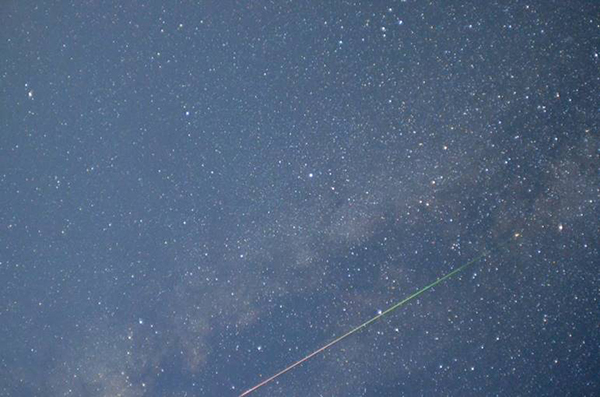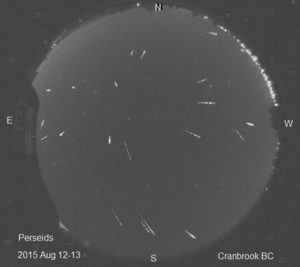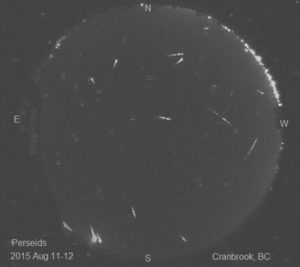Home »

Perseid Meteor Shower returning
By Rick Nowell
The annual Perseid Meteor shower peak occurs Tuesday night, August 11 and Wednesday morning August 12. The next evening Wednesday Aug 12/13 is almost as good.
The bright Moon (half lit) is going to ruin some of the viewing when it rises at 1 a.m. Hopefully we won’t have forest-fire smoke this year. Even so, we should still be able to see meteors overhead. Two years ago the Perseids were twice as active, at over 120 meteors per hour, or two per minute.
Best times for viewing would be Wednesday morning around 3 to 4 a.m. (the final dark hour before dawn) when the constellation Perseus rises highest in the sky.
To see the most meteors, go out of town to a dark location and try to stay in the shadow of the Moon to minimize its bright light in your eyes. Rates are estimated to be about 50 to 75 meteors per hour (one per minute).
Off-Peak: After the max, the rates will decrease by 50% each night. It takes the Earth a week to pass through the ice and dust trail from comet Swift-Tuttle. The shower will gradually taper off and end by Aug 24.
The above photo taken near Cranbrook shows a meteor streaking through Aquila. Starting green and turning red as it slows down. The bright star Altair is at the top left of the photo. Those aren’t clouds, that’s the Milky Way glow and dark gases visible. Scutum (the Shield) is the small “C” shape at bottom in the Milky Way, 1/4 from bottom left. {Shot with a Nikon D7000 with a Vivitar 28mm f/2.0 lens; 15 second exposure at 6400 iso. Photo Credit R. Nowell}
Their trails will all point to the constellation Perseus (if it’s a Perseid). The closer they are to Perseus, the smaller their trail: and the further away, the longer the trail. Look for their colours—at high speed (an average of 59km/s) they compress and ionize the air to a green; then that fades to yellow, orange, red as it slows down.
If they disrupt and flare, you may see green/bluish wide streaks that glow afterward for a second or two (mainly it’s water ice, but there may be trace metals present like copper or cobalt). None of these 1cm diameter ice pellets will hit the ground, they vaporize up in the upper atmosphere above 80 km.
Where to look?
 The composite photos above and right show the entire sky, and all the meteors that fell on 11 and 12 Aug. 2015 over Cranbrook; taken by our college meteor camera. Perseus is the constellation to the Northeast (middle left side of the photo). Normally there are fewer meteors seen straight overhead, since there is less volume of atmosphere overhead. There are slightly more meteors seen high to the West around Hercules and above the handle of the big dipper; since the meteor trails are longer there, and the meteors skim lower in a greater volume of atmosphere. That’s where I aim my cameras. (Or where it’s darkest, away from the Moon or city streetlight glow).
The composite photos above and right show the entire sky, and all the meteors that fell on 11 and 12 Aug. 2015 over Cranbrook; taken by our college meteor camera. Perseus is the constellation to the Northeast (middle left side of the photo). Normally there are fewer meteors seen straight overhead, since there is less volume of atmosphere overhead. There are slightly more meteors seen high to the West around Hercules and above the handle of the big dipper; since the meteor trails are longer there, and the meteors skim lower in a greater volume of atmosphere. That’s where I aim my cameras. (Or where it’s darkest, away from the Moon or city streetlight glow).
Some of the meteors seen will be from the k-Cygnids running from August 3–25. These peak on August 18 at three meteors per hour, when the skies will be dark, no Moon. They usually show a number of slow falling fireballs moving at 25km/second. Cygnus the Swan will be directly overhead at midnight.
Rick Nowell is the Physics Lab Tech at College of the Rockies in Cranbrook








